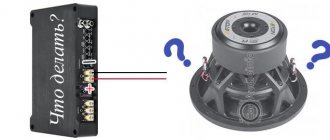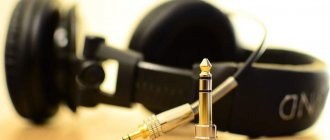Mostly all modern TV models, including the Premium segment, are equipped with far from the highest quality sound systems. It is not surprising that almost all users have questions regarding sound.
The fact is that manufacturers initially expect that the built-in speakers will later be used in conjunction with a home theater audio system. Therefore, if you are tired of quiet, wheezing speakers, then you should connect your own speakers.
The user will be able to connect the most ordinary speakers from a computer or more expensive models with a subwoofer. The equipment is connected according to approximately the same principle. Now we’ll look in detail at how to connect speakers to a TV, and also try to choose the highest quality equipment.
Types of inputs and connectors
First you need to determine what ports the TV is equipped with; based on this, the optimal method for connecting the speakers will be selected. Modern TV models are equipped with universal interfaces that allow you to connect different types of speakers:
- digital interface HDMI ARC (Audio Return Channel);
- special purpose connectors – Scart, RCA;
- standard jack for connecting headphones and headsets;
- line input.
The connectors connecting the tulips allow you to connect speakers that are not equipped with an amplifier. The main thing is that the user chooses the right acoustics; its power should not exceed the established range. If the TV has an output for tulips, but the acoustic device does not, use an adapter.
The last two methods are relevant when the device is not equipped with other connectors. Quite often, old equipment with a built-in amplifier is connected this way.
Using the HDMI ARC interface, you can connect a modern system to the plasma, in particular home theater speakers that can broadcast truly high-quality sound. Not all TV device models are equipped with this connector. A regular HDMI input will not work for this.
What slot do we need
Any system unit that uses an integrated sound card on a motherboard has several 3.5 mm jack ports used to connect various devices. Their color marking has long been standardized:
- Red or pink – microphone input. Used exclusively to connect a microphone, including the one built into the headset.
- Blue or cyan – linear input. Used to connect all other external audio sources. It is not recommended to insert a microphone here - either the device itself or the motherboard may short out.
- Green or salad. The correct name is line output, used to connect audio speakers or headphones.
If you are using a headset from a phone with a 3.5 jack, then most likely you won’t be able to use them in a PC (in the system unit) without the appropriate adapter or adapter.
The fact is that the pinout of the plug from such headphones and from speakers is slightly different. The speakers use a three-pin jack - two channels plus ground. The telephone headset has 4 channels: two speakers, ground and a microphone. If this is not a headset, but regular headphones, in some cases an adapter can solve the problem.
But in modern laptops (new ones) everything is already provided and you don’t have to worry about it.) The 2.5 jack connector is almost never used anymore.
Connecting active speakers
The compact design of the TV does not allow the manufacturer to place truly powerful speakers. For this reason, users have complaints about the sound. However, the problem is easily solved by connecting an external device to play sound. Of course, the difference will be noticeable immediately.
Even PC hardware will perform better than a standard TV speaker. You can connect active speakers to any TV; the model does not play a special role. It is immediately necessary to indicate that they are connected using a special interface.
What are powerful speakers? Everything is very simple, these are speakers or an audio system with a built-in, powerful amplifier. It is this that significantly improves the sound. The amplifier is found in all active type devices, including even the most ordinary speakers.
Of course, the process of outputting sound to speakers, and connecting in general, is greatly simplified. The user simply inserts the audio system plug into the corresponding connector; there is no need to additionally connect an amplifier, since it is already built into the speakers. You also need to turn on the device to play audio on the network. Again, external type equipment is connected directly, that is, without any adapters or connectors.
On the back of your TV equipment you will find a huge number of different ports. To determine which socket you need, pay attention to the corresponding markers (signatures). Basic knowledge of English will be sufficient. Marking allows the average consumer to determine the purpose of a particular connector without unnecessary problems.
To connect computer speakers to your TV, find the audio connector; it is often white or red. This is an international marking, so the color remains the same regardless of the model and manufacturer of the equipment. Even beginners will definitely not get confused. Please note that the plug should be inserted into the Audio-R (white) and Audio-L (red) sockets.
Regardless of the type of active acoustics, it can also be connected using the most common round input - its diameter is 3.5 millimeters. Quite often this interface is called a mini jack or TRS. Near such a port there is almost always a marker in the form of headphones, so it will be very difficult to make a mistake.
Both TVs and computers are equipped with identical connectors for connecting speakers. Older TV models are equipped with tulips. Of course, in this case the audio system must be equipped with a similar interface. If this input is missing, you can always use an adapter. Now you know how to connect a speaker system to your TV.
Connecting speakers
Home / Information / Connecting speaker systems
Information / Connecting speakers
In professional work with sound, it is very important to understand the basic principles of switching different types of equipment; this makes it easier and faster to achieve high-quality sound and extend the life of the equipment.
Considering acoustic systems in this light, three types can be distinguished: active, passive and broadcast acoustic systems. Each type has its own characteristics, which we will consider in this article.
So, we assume that you have chosen a speaker system and bought it. After unpacking the equipment, the first question that arises is the connection.
Active acoustics. The main difference between active and passive acoustics is the presence of an amplifier built into its housing. This means that the power of the sound signal supplied to the active acoustic system (hereinafter referred to as speakers) is significantly less than to the passive one. Therefore, these speakers use their own cables and connectors designed for lower current and voltage.
Levels. Although line signal levels are standardized, inconsistencies between devices can still occur. Because in fact, in audio technology, not one standard is used, but several. The most popular line levels for audio equipment are +4 dB (1.23 V), -10 dB (0.25 V) and -10 dBV (0.32 V). As a result of a mismatch between the levels of the output device (for example, a mixer) and the input device (for example, an active speaker), the signal may be distorted or receive a large level of noise. In this regard, on devices we can often see switches for the nominal output and input levels. If there is no such switch and there is no output level regulator, then you will have to use an additional matching device.
Balance and imbalance. For high-quality signal transmission, the cable suitable for the active speaker must be shielded. It is also important to understand that the connection can be balanced or unbalanced. An unbalanced connection (unbalanced) is a connection using a single-core shielded wire. A balanced connection (symmetrical) is a connection using two shielded wires. One of the wires transmits an unchanged signal (+), and the second transmits a signal in antiphase (-). Such signal transmission allows the use of devices that, based on signal subtraction, help to effectively combat interference and interference. In practice, an unbalanced connection is more often used as jumper wires between equipment, that is, when the source and receiver are located nearby. A balanced connection is recommended for use at a distance of more than 20 meters and allows high-quality signal transmission over 200 meters. The signal transmission methods in the connected devices must be consistent; the balanced input must be connected to the balanced output. Otherwise, adapters or devices for matching the signal transmission method are used.
Hi-z. The Hi-Z input is a high impedance input that provides an impedance-matched connection between the speaker system and the guitar's pickups. That is, it is an unbalanced input for acoustic guitar, lead and bass guitar. It is also called instrument input.
Use of optional patch adapters should be done with caution. It is necessary to take into account all the above-mentioned characteristics, they must match: the input and output must have the same nominal signal level (+4 dB, -10 dB, etc.), transmission method (balance/unbalance) and impedance (input and output impedance).
Connectors. Popular powered speaker connections include XLR, RCA, and TRS.
The most popular connector in speaker systems is XLR.
Known for its high reliability. Coming into sound from aviation, the XLR connector, or as it is also called “Canon”, has successfully taken root in most professional audio equipment. The three-pin type of connector is most familiar to us, although they come in four, five, and sometimes more-pin types. Almost always, the contacts on the connector are labeled: 1 – body and/or ground, 2 – plus signal (+), 3 – minus signal (-). It can be wired for both an unbalanced connection (pins 1 and 2 are used) and a balanced connection (pins 1, 2, 3). The connector uses a latch mechanism that locks the position.
TRS and TS connectors. The “Jack” connector comes in three-pin TRS and two-pin TS.
The abbreviation stands for contact designations: 1 – Sleeve (sleeve) ground and/or body, 2 – Tip (tip) signal plus (+), 3 – Ring (ring) signal minus (-). It is clear that the TS plug can only transmit an unbalanced signal. TRS can be wired for both balance and unbalance. The size of the connector can be quarter-inch (TRS1/4”) and 1/8-inch (TRS1/8”, 3.5 mm), also called a minijack.
A connector that is often used in both professional and household equipment is the RCA connector.
People call it "tulip". It is not the most correct connection of devices from an engineering point of view. This is because at the moment of connection the signal is connected as the first contact, and not the ground contact as it should be. However, thanks to its shape and low cost, it firmly occupies its position among the popular connectors. Transmits an unbalanced signal at line level.
Almost every modern professional active speaker has a pass-through output on an XLR connector in its housing.
This output can be called differently - Link Output, Mix Out, Thru Out, Line Out, but the essence is the same - to give the signal input to the speakers for further routing. Depending on the speaker model, the output signal may be absolutely identical to the input signal or undergo some changes. For example, an already limited signal or a signal after a high-pass filter can be sent to the output. If the speaker system has a built-in mixer for several channels, then the signal from only a specific input or the total signal from all inputs can be sent to the output. Such questions can be clarified by reviewing the instructions for the speaker. This connection concept allows you to create long lines of speaker systems without running a cable from the mixer to each speaker.
The through output is also used when connecting subwoofers and satellites. It is important to “place” all the speaker systems used as a portal system on one stereo output of the mixer - Main Mix, in order to control the sound in the auditorium with one fader. Speakers performing monitor functions are connected to separate outputs of the mixer. Typically, in such a situation, the sound from the mixer from the Main Mix output is supplied to one/two subwoofers, and further from it/them, using the through output, the signal is supplied to the satellites.
It turns out that if you can connect one subwoofer with two satellites, and the sound is first supplied to it, then the subwoofer must contain two independent channels in order to send stereo to the satellites. Below in the picture we can see a diagram of a typical subwoofer panel with connectors.
Here the connections are made using balanced XLR connectors. The two channels are named A and B. Outputs: FullRange – full range of the signal, HighPass – signal after the high-pass filter. From the HighPass output, the signal from the subwoofer is sent to the satellites, from Full Range - to another subwoofer (if you have four subwoofers and two satellites).
Connection diagram (one subwoofer and two satellites):
Connection diagram (two subwoofers and two satellites):
Connection diagram (four subwoofers and two satellites, floor monitors):
Passive acoustics. When connecting passive speaker systems, you should start by checking that the power of the connected amplifier and the speakers match. This is the most important question. If the selection is incorrect, distortion (overload) of the amplifier's output signal appears, which can lead to damage to the acoustics. The output power of the amplifier should be equal to the power of the acoustics or 5 to 10 percent more. It is best to use an amplifier at 90% power (which corresponds to the maximum speaker power) than a lower power amplifier at 100% power, which does not reach the maximum speaker power ratings. If the amplifier power is insufficient, the acoustics will not “open up” completely. It is necessary to ensure that when selecting capacities, the power indicators of the same standards are compared.
Power. Manufacturers use power standards such as rated, peak, sine, DIN, RMS, AES, PMPO, Program power. And that's not all the existing power standards. Some powers are close in terms of performance, but still, do not forget that these are different powers! Such a variety of capacities can be justified by different standardization approaches in different countries. For Russia, the standards for rated and sinusoidal power are native, DIN refers to the German Institute for Standardization, RMS, AES, PMPO are Western standards. The most objective indicators are nominal (Nominal) and root mean square (RMS) power; the PMPO standard is considered the most “frivolous”, since it is difficult to truly objectively assess the power of speaker systems. There are formulas that allow you to at least roughly convert one power into the equivalent of another.
The easiest option for a buyer in selecting speakers and an amplifier is to choose devices from the same company, since large companies usually produce specific series of amplifiers in conjunction with specific speakers, repeatedly checking the reliability of such sets and optimizing their operation. A hint can be provided by brochures produced by manufacturers, which describe the optimal options for combining series of amplifiers with speakers.
Resistance. It is important to remember to match the device resistances. So for an amplifier, the technical specifications usually indicate several powers for operating resistances (for example, 2000 W for 8 Ohms / 4000 W for 4 Ohms / 6000 W for 2 Ohms). The most popular speaker impedances are 8 and 4 ohms, and not every amplifier can work with 2 ohms. These features echo the well-known concepts of serial and parallel connection of speakers. There are often situations when you need to load four speakers onto a stereo amplifier. If, for example, you connect four 4-ohm speakers to a two-channel amplifier in series, then their total resistance will be 16 ohms. We do not drop to dangerous resistance values, but we do lose power with this connection. With a parallel connection, the output power increases, however, in our case, the resistance drops to 2 Ohms. This means that the amplifier will run noticeably hotter due to the higher current. And in general, before using such a connection, you should make sure in the amplifier’s passport that it works with a 2-ohm load, otherwise there will be trouble. It is believed that at 2 ohms the amplifier's ability to control the movement of the speaker cone is reduced, which can result in a washed out bass sound.
Wire section. Everyone probably understands that although the cable resistance is low, it is there, which means it still causes a voltage drop. That is, the signal level drops, especially at high frequencies. The trick is that the resistance depends not only on the material and length of the wire, but also on its cross-sectional area. The larger the cross-section, the lower the resistance. The technical specifications for the cable must indicate the linear resistance. This means that, armed with a calculator, you can calculate, based on the length you need, what resistance the wires will have.
Phase. When connecting passive speakers, it is very important to ensure that the phases of the speakers match. This means that the cones of all speakers must move in the same direction at any given time. Usually, for convenient connection, the manufacturer marks the contacts on the speakers and the wires extending from them with marks (+) and (-). If the phasing is incorrect, the speaker cones will move in the opposite direction and thereby reduce to zero all repeating amplitudes in their signals. Since the bass component in a stereo signal is almost always the same (meaning a band within approximately 30 - 130 Hz), this part of the signal will disappear in the “anti-phase” mode. In practice, you can see a picture when two speakers standing separately produce normal sound. When the low-frequency component is turned on at the same time, it disappears. This means that one of the speakers has the plus and minus contacts connected incorrectly.
Connectors. The most popular connectors for professional amplifiers are Speakon, XLR, TS, Euroblock, and screw terminals.
XLR, TRS/TS, Euroblock – used to connect the signal input to the amplifier.
Speakon, TS, screw terminals – for connecting speaker systems to an amplifier.
TS connector. The contacts are connected as follows: the signal contact (+) is connected to the Tip contact, and the signal contact (-) is connected to the Sleeve contact.
Speakon connectors come in three styles: 8-pin, 4-pin, and 2-pin. The most popular are 4-pin - they are used to connect two-way speakers. To connect three-way ones, 8-pin ones are used. Thanks to its design, it is a very reliable connector. After connecting to the socket, the plug must be turned clockwise to secure the contacts.
Screw clamps allow you to fix wires with special metal clamps and simply stripped bare wire ends.
Routing. Most modern stereo amplifiers have Stereo, Parallel, Bridge routing modes. Typically the two channels are labeled "A" and "B". Stereo mode provides operation of two independent channels, Parallel mode provides parallel supply of a signal from input A to output A and B, while input B is not active, but each output has its own volume control, and Bridge mode will help provide maximum power per speaker, while regulator A is active.
Connection diagram (Stereo mode):
Connection diagram (Parallel mode):
Connection diagram (Bridge mode):
In the above diagrams, the speakers are connected in bridge mode using screw terminals. However, this is not the only connector on which bridge mode can be implemented. Let's take a closer look at this connection on the Speakon connector. Connector pins:
To connect the bridge mode, the wires are connected to the output contacts of channel A (pins 1+ and 2+):
Connecting speakers to an amplifier using Speakon connectors for parallel and stereo modes is the same, the only difference is in the routing itself inside the amplifier.
Stereo mode:
Parallel mode:
It can be seen from the diagrams that the stereo connection can be made either on two Speakon connectors or on one. With a double connection, contacts 1+ and 1- are used on each connector; when two speakers are connected to one connector in one plug, all four contacts 1+, 1-, 2+, 2- are used. Changing modes in the amplifier can be implemented in the form of a physical switch or in the control menu of the DSP processor.
Division into stripes. The next question is inextricably linked with the previous one. Since a professional amplifier can work equally well with both wide-range speakers and subwoofers, it is very convenient when the amplifier is equipped with a built-in crossover. This eliminates the need for additional hardware and additional switching. Since when using satellites with subwoofers it is recommended to cut off the low-frequency component, an amplifier with a built-in crossover must implement three functions - low-pass filter, high-pass filter, full range.
Let's consider options for connecting speakers to one two-channel amplifier with a crossover. Let's start with something simple.
Normal stereo mode with two full-range speakers:
Mono mode with one subwoofer and one satellite:
This mode is preferable to use when a stereo signal is not required, but increased demands are placed on the bass response.
Biamping and biwiring (Bi-Amping and Bi-Wiring). To consider the next connection you need to understand what biamping is. Biamping is a connection scheme in which each speaker of a two-way speaker system requires a separate amplifier channel. That is, such a speaker simply does not have a built-in crossover and each of the two channels supplied to the speaker must be respectively tuned to the low-frequency or mid/high-frequency band. Biwiring is a connection scheme in which wires from one amplifier channel are connected separately to the woofer and mid/tweeter speakers. Since they are still connected to one channel of the amplifier, it turns out that it must be broadband, which means that the speaker system must have a low-pass and high-pass filter installed for each speaker. That is, the same crossover, only on some kind of separate structure with filters. The benefits of this connection method are questionable, unlike biamping. Biamping can be useful in cases where, for some reason, it is impossible to place a crossover in the speakers.
Connecting a two-way speaker using a biamping scheme:
All principles of matching an amplifier and speakers are also relevant for multi-channel amplifiers. The difference is only in the number of channels and speaker systems; routing of such amplifiers also becomes more complicated. Any multi-channel amplifier can theoretically be replaced by a set of two and single channel amplifiers.
In addition to the connections of active and passive speaker systems that we have considered, we can also touch on a separate area - connecting broadcast speaker systems.
Broadcast acoustics. This equipment is fundamentally different from passive and even more so from active acoustics. The peculiarity of broadcast systems is that thanks to the use of step-down and step-up transformers in the designs of amplifiers and speakers, high-quality sound transmission over long distances is achieved. Therefore, this sound system is in demand in enterprises, offices, supermarkets, etc. Naturally, without much experience, it is very difficult to design and configure a broadcast system yourself; it is better to entrust this task to professionals.
Let's consider the basic principles of connecting broadcast speaker systems:
- There are broadcast lines with signal voltage levels of 240 V, 100 V, 70 V, 30 V and others. The AC terminals must correspond to the line voltage, that is, have the corresponding input voltage;
- when connecting speaker systems to an amplifier, remember that their total power should not exceed the power of the amplifier;
- With 100 V and 70 V amplifier modes available, speakers can be switched from a 100 V line to a 70 V line. In this case, the power of these speakers will drop by half, at the same time their number can be doubled.
- Some speakers have leads not only for high-impedance loads, but also for low-impedance loads. Usually the purpose of the contacts is written on the case; it is important not to confuse them when connecting.
- selection of AC transformer terminals - the lower the AC resistance you choose, the more power it will produce.
Ordering and delivery information Selecting speaker systems Connecting speaker systems
Connecting passive speakers
Passive audio systems differ from active ones in the absence of a built-in amplifier. Is it possible to connect passive acoustics to a TV using a cable? To begin, the audio system is connected to an amplifier. Hence, it connects to the TV.
To establish a connection, users connect the speaker to the TV using cables; sometimes they are included in the basic equipment package, and in some situations they have to be purchased separately.
You definitely need to check one very important nuance: in accordance with the specification, the amplifier's power rating must be at least 30% of that of the speaker system. The wire is selected in accordance with a cross-sectional area greater than 1 square millimeter. Of course, the thicker the cord, the more reliable the cable.
When trying to connect speakers to a TV without an amplifier, you should definitely take into account the output impedance parameter. The value of this indicator must be nominal and correspond to the resistance of the audio system. Polarity must be taken into account, in particular, connect the left channel to the left speaker. Accordingly, we connect the right one to the right speaker. If you ignore this principle, the sound quality will noticeably drop.
Mostly outdated equipment is equipped with “tulip” or “mini-jack” connectors. In situations where it is necessary to connect acoustics, which consists of several passive speakers at once, an AV receiver is used. It requires a separate cable. This is perhaps the easiest way to configure the equipment.
An alternative option is to connect acoustics via the HDMI ARC interface. This method allows you to achieve the highest quality sound. Therefore, if such a connector exists, then give preference to it.
Front panel
The front panel of the case can be equipped with additional slots for connecting a microphone and headphones. As a rule, they either have the same color coding as indicated above, or are indicated by the corresponding icons.
Please note that for a PC with a headphone jack on the front panel, activating this port requires the installation of additional audio drivers - for example, AC'97 or similar.
The convenience is that before changing the slot through which sound will be output, the OS asks the user when connecting a new device which slot should be used as the default.
Which connector to insert audio devices into is a matter of personal preference of the user, since they do not differ in sound quality.
For example, during the day you can listen to music loudly through acoustic speakers connected to the back cover of the case. And in the evening, so as not to disturb anyone, use headphones, connecting them to the front panel and changing the settings in the dialog box that appears.
Also, do not forget that these options are only available if the slots on the front panel are connected to the corresponding connectors on the motherboard.
If the sockets are not connected, the OS will not receive a request, since even with the AC'97 driver active, it simply will not see either the port or the connected device.
Connecting a music center
Many users use special audio centers to listen to music. The speakers of such equipment are capable of reproducing sound of maximum quality.
The music center is considered obsolete equipment, so connection is made using tulips. If your TV does not have this connector, be sure to buy an adapter.
This type of acoustics guarantees not only high quality, but also maximum sound volume. Some models are equipped with a subwoofer. You can connect to your TV using bells or TRS. These cables are sold at their respective stores. Find the OUT output on the back of the TV, and the IN connector on the music center, connect them with a cable and enjoy the sound.
Stereo connection
Every user will be able to connect a stereo system, since it is an ordinary amplifier to which passive speakers with different power ratings are connected. The connection is made via a tulip connector, but you may have to buy RCA and TRS adapters first.
To connect active speakers to Smart TV, you must use the appropriate cables, otherwise the sound quality will be unsatisfactory.
Home theater connection
Without a doubt, this method provides the best quality of sound signal transmission. It is for this reason that professionals call home theater the optimal and most modern stereo system.
Firstly, home theaters are equipped with professional receivers and powerful amplifiers, and therefore the sound output from the speakers is especially clear and very voluminous.
Experts strongly recommend that before you start connecting, you carefully study the instructions and strictly follow all the provisions reflected in it. Of course, before installation it is necessary to de-energize the TV, otherwise there is a high probability of a short circuit.
Thus, you see that connecting an external device to the TV is quite possible, even without experience in carrying out such work.











